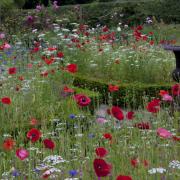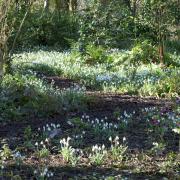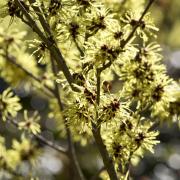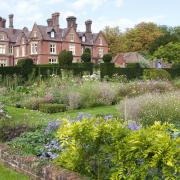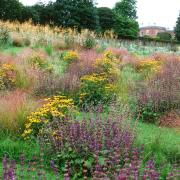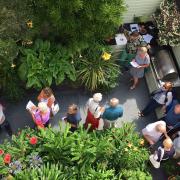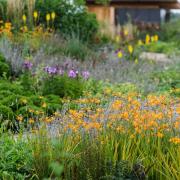Take time this month to explore the delightful spring gardens at the Warde family's historic Squerryes Court in Westerham
Garden of the month: Squerryes Court in Westerham
Take time this month to explore the delightful spring gardens at the Warde family’s historic Squerryes Court in Westerham
A visit to the charming gardens at Squerryes Court, home to the Warde family, is lovely at any time through the seasons.An air of nostalgia pervades the landscape as you wander through the formal parterres, along the borders or in the timeless woodland.
The gardens fit perfectly into their surroundings, with 15 acres of garden, lake and woodland, spreading out from the 17th-century manor house.
“I think that a good garden must have a strong design which is infilled with planting that is not too organised or stiff and everything should flow naturally into the distance,” says Anthea Warde.
“Close to the house, the parterres, lawn, topiary, hedges and paths are very formal to frame the beautiful symmetric house. As you go further away, the grass gets gradually longer until it becomes the meadow grass and beyond is the wild garden with carpets of naturalised snowdrops, bluebells and daffodils in the spring,”
It comes as no surprise to learn that the house and grounds have been used as a location for many period productions, most recently the BBC adaptation of Jane Austen’s Emma (Kent Life, October 2009).
“I was thrilled that Mr Knightley proposed to Emma in the garden,” says Anthea, who moved into the house in 1980 with her husband John, continuing the tradition of the Warde family living at Squerryes since 1731.
I was thrilled that Mr Knightley proposed to Emma in the garden
Fortunately, most of the wonderful collection of pictures, porcelain and furniture from the 18th century has survived the centuries. The gardens, however, have seen great change over the centuries.
There has been a garden at Squerryes since the 14th century, originally around the previous timber-framed house. Many plans survive depicting the different phases of the garden. The earliest, dated 1686, shows some medieval features around the present house that was built the same year by Sir Nicholas Crispe.
Around 1700, the gardens were laid out in the formal style of the day and later in the 18th century they were landscaped in the then fashionable romantic, natural style. The Victorians later added rhododendrons and rockeries.
Through the war eras, as with many estates, the house was let and priorities changed. When the family returned after the war, they had two milking cows, Buttercup and Daisy, grazing at the top of the garden! Further impact on the garden came with the Great Storm of 1987 when 147 mature trees were lost.
The storm became the impetus for the family to restore part of the formal garden, using a 1719 plan, complete with accurate plant list, and a Badeslade print as guides. The owner from 1700, The Earl of Jersey, was Lord Chamberlain and Master of the Court to William III and would have witnessed the making of Hampton’s Court Privy Garden, which clearly influenced the design for Squerryes.
Fortunately, some of the original paths and terracing of the old garden remained, giving a framework for re-instating the parterre, a semicircle of lime trees, a hornbeam avenue and yew hedges.
“I was very lucky to have the advice of garden consultant, Tom Wright, who helped lay out the formal garden, hedges, vistas etc. when we restored the garden,” says Andrea. “We only have one full-time gardener, Terry Darton, with some part-time help and so if we do create a new feature or border, we always have to consider the upkeep and future maintenance of what we have done. This was a valuable lesson learnt from Tom.”
With such an important garden, restoration and evolution of the garden is ongoing. Many areas of the garden have a story behind them, a part of the historic timeline and fabric of a garden remaining in the same family for centuries.
For example, the gazebo on the lake, built in 1735, allowed John Warde a vantage point to watch his horses being exercised and the cenotaph was erected by the family to commemorate the life of family friend, General Wolfe, who died in 1759, at the spot he was believed to have received his first commission into the army.
Anthea enthusiastically embraces the custodianship of the gardens. “I have always been passionate about gardening, even as a child, and much of this was inherited from my mother who was a brilliant gardener,” she says.
“I was so lucky to have a blank canvas to work with as very little had been done in the garden since the 1930s. I have always been deeply involved with the garden – all the developments, plant choices etc. I have been lucky to see the garden mature and I love every aspect of it and watching it change through the seasons,” she beams.
Squerryes Court and Gardens, Westerham
Open: Apr to end Sep, Wed, Sun and Bank Holidays, garden 11.30am-5pm, house 1pm-5pm
April in the garden
Plant of the month
Fritillaria meleagris
snake’s head fritillary
native perennial bulb nodding bell flowers muted patterned purple, green or white flowers
cultivation
naturalise in moist meadows or in drifts under shrubs humus-rich, well-drained but moisture-retentive soil full sun to light shade fully hardy plant bulbs at four times their depth divide offsets in late summer prone to attack from slugs and lily beetles Ornamental tasks for a continuous display of flowers, perennials and annuals can be planted now put stakes or supports in place ready for tall plants to grow through prune and tidy shrubs, dead head flowers and feed good time to choose ornamental trees with all the lovely blossom out. Select ones with good autumn colour and attractive bark as well divide perennials to propagate To taste continue sowing broad beans, mangetout, lettuce, beetroot, carrots, chard, peas and spinach sow some herbs, such as parsley and chives plant asparagus crowns in well-prepared soil plant shallots, garlic and onion sets start pruning trained fruit, plum and cherry trees
Something extra
Have fun making a scarecrow - once a familiar sight in fields and allotments to help scare off hungry birds from crops. Most effective when frequently moved through the garden and have a bit of added ‘bling’ with shimmering objects. Tiny ones could be used for potted produce, larger in the veg plot or allotment. Ensure plenty of ‘flap’ with dangling scarves, flowing skirts, over-long sleeves, etc., as unexpected movement will hopefully send the birds flying. The base may be woven willow prunings, bamboo canes or sticks twined together. An old pillowcase, stuffed, makes a great head.



